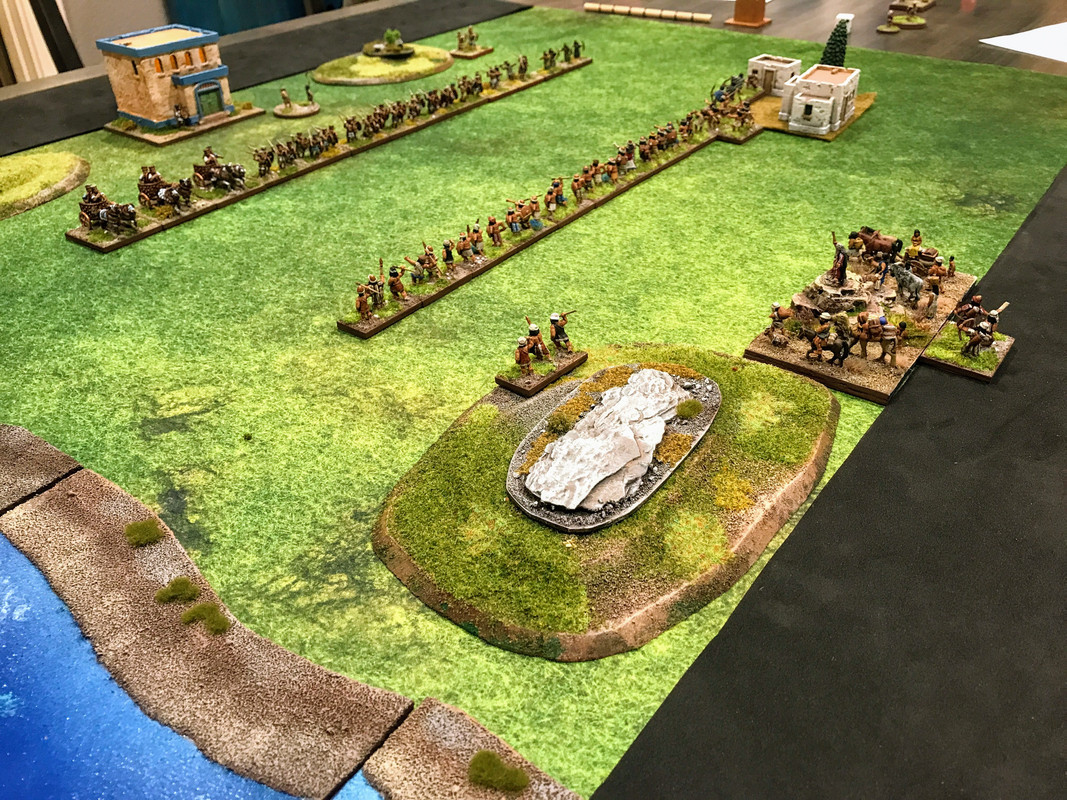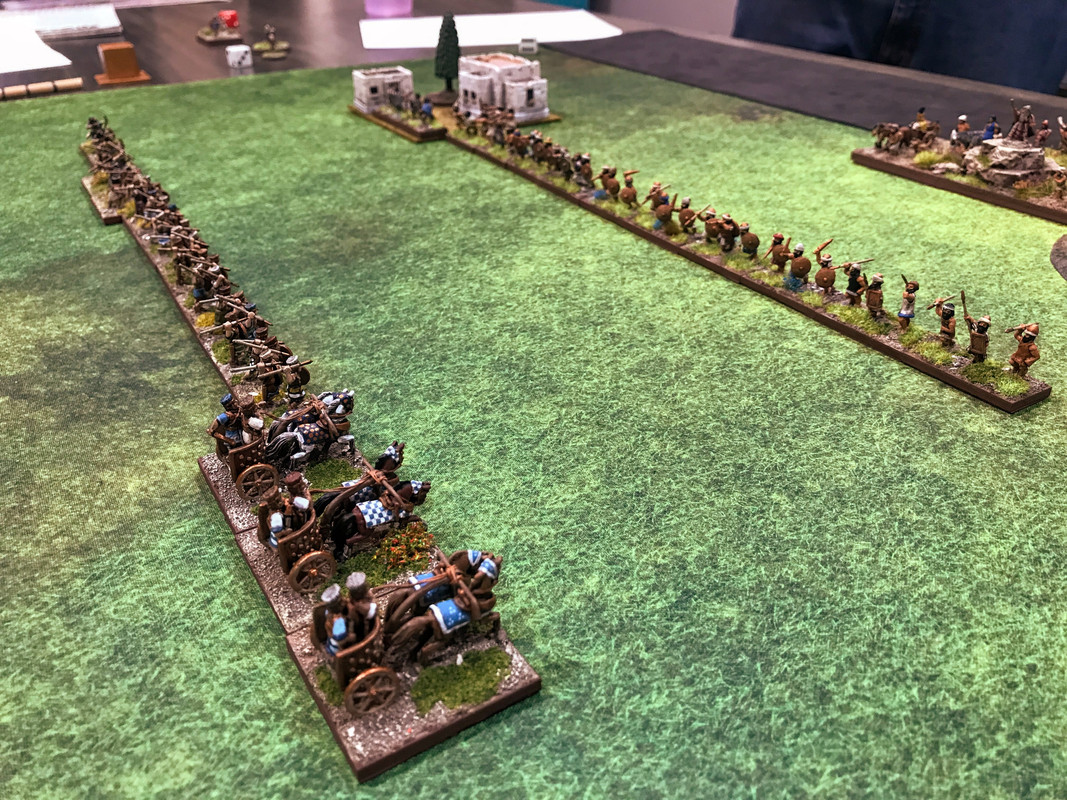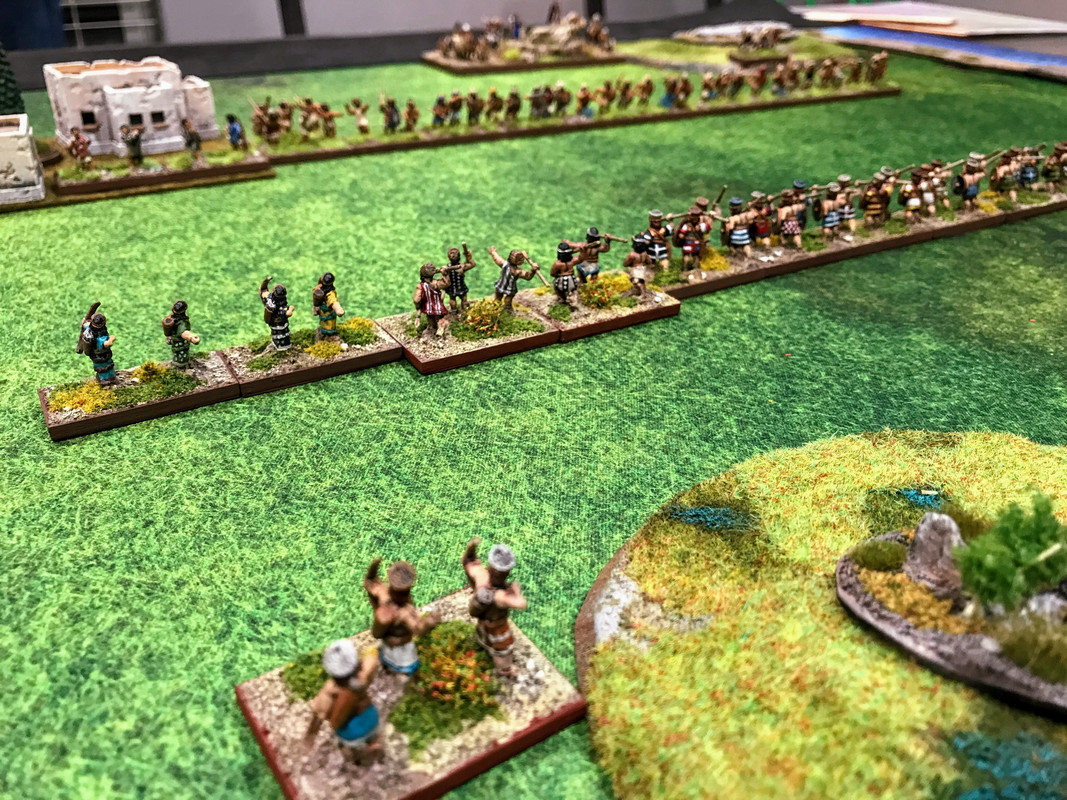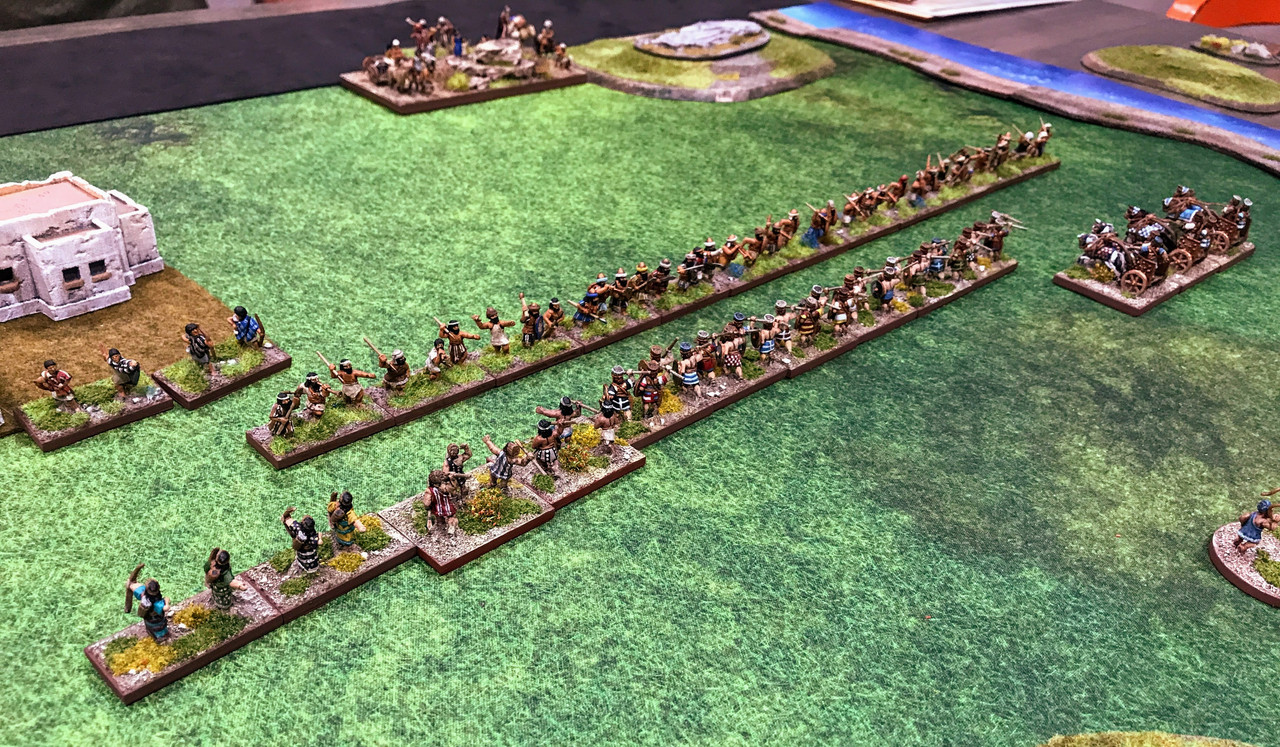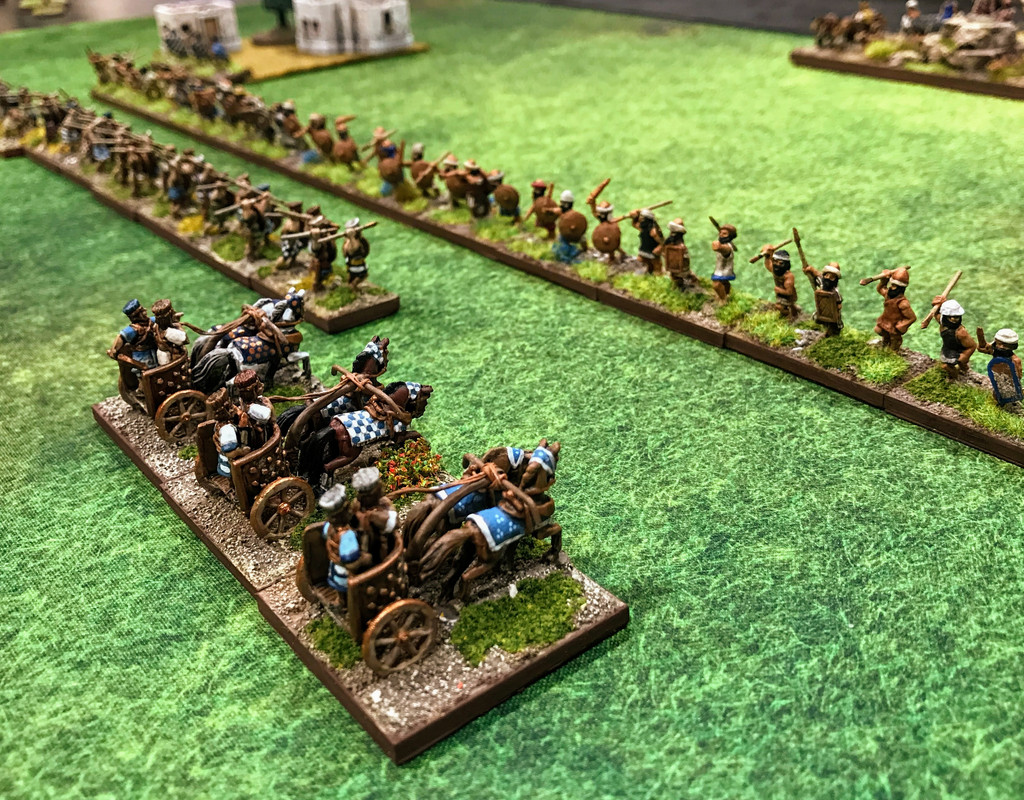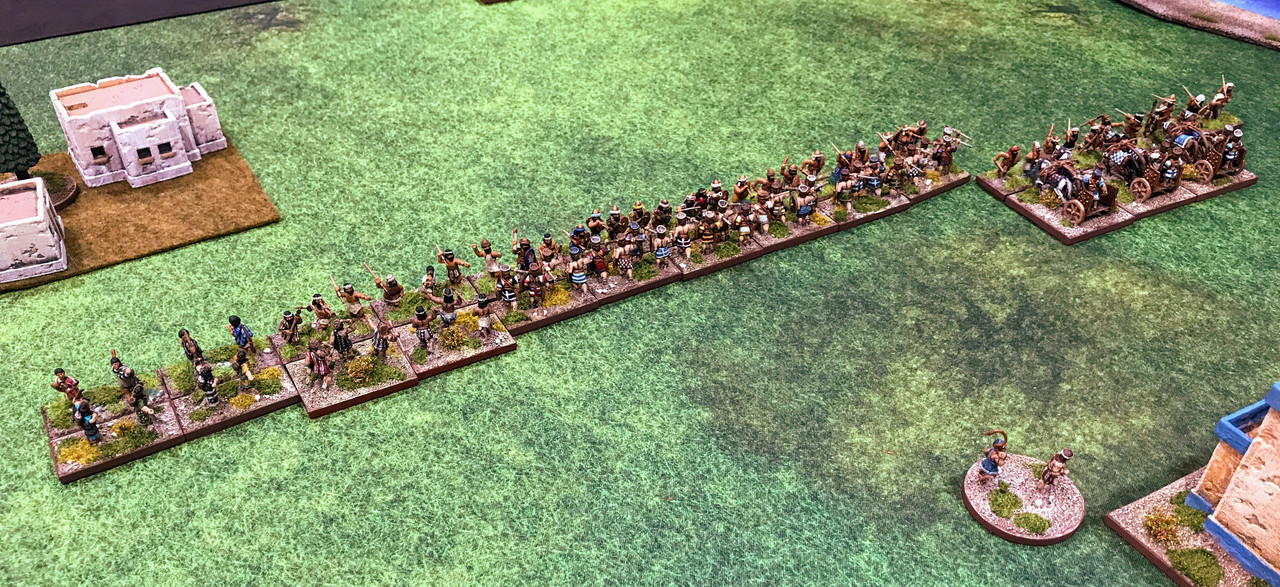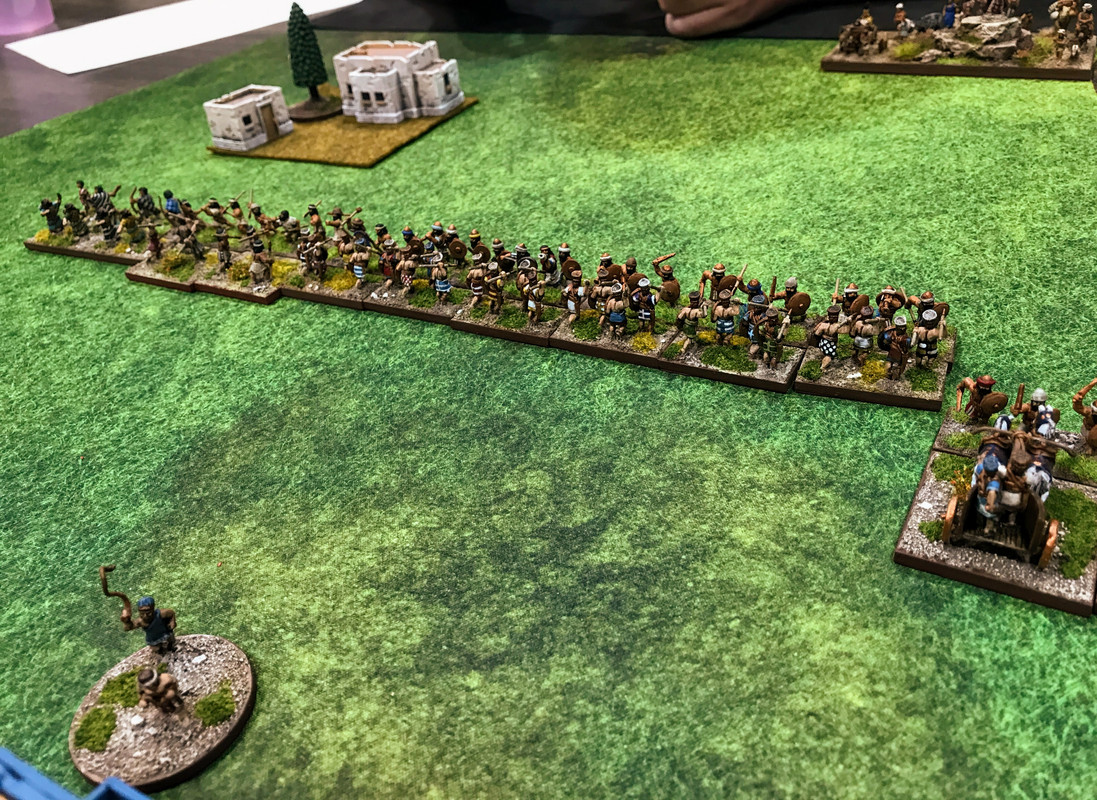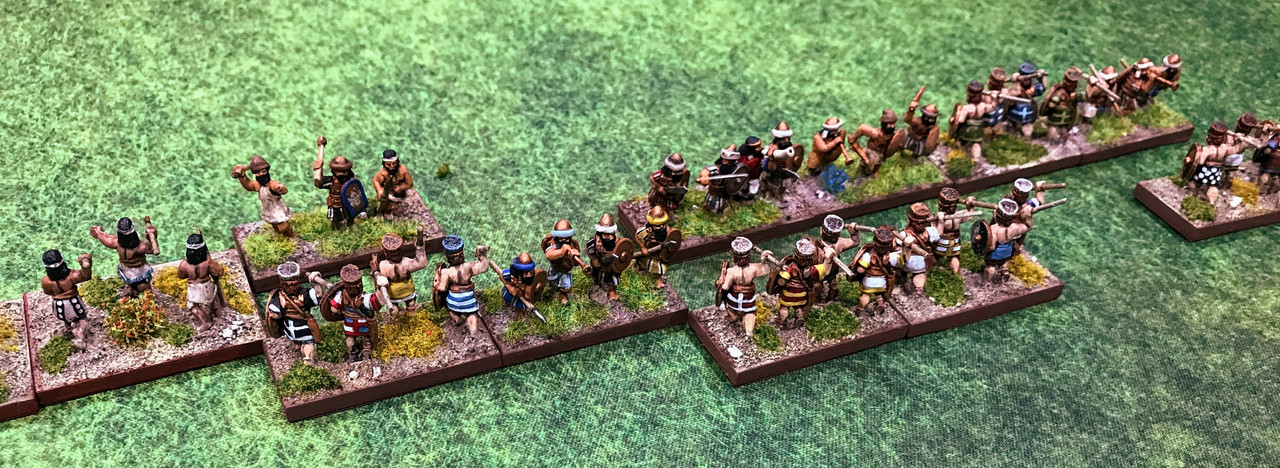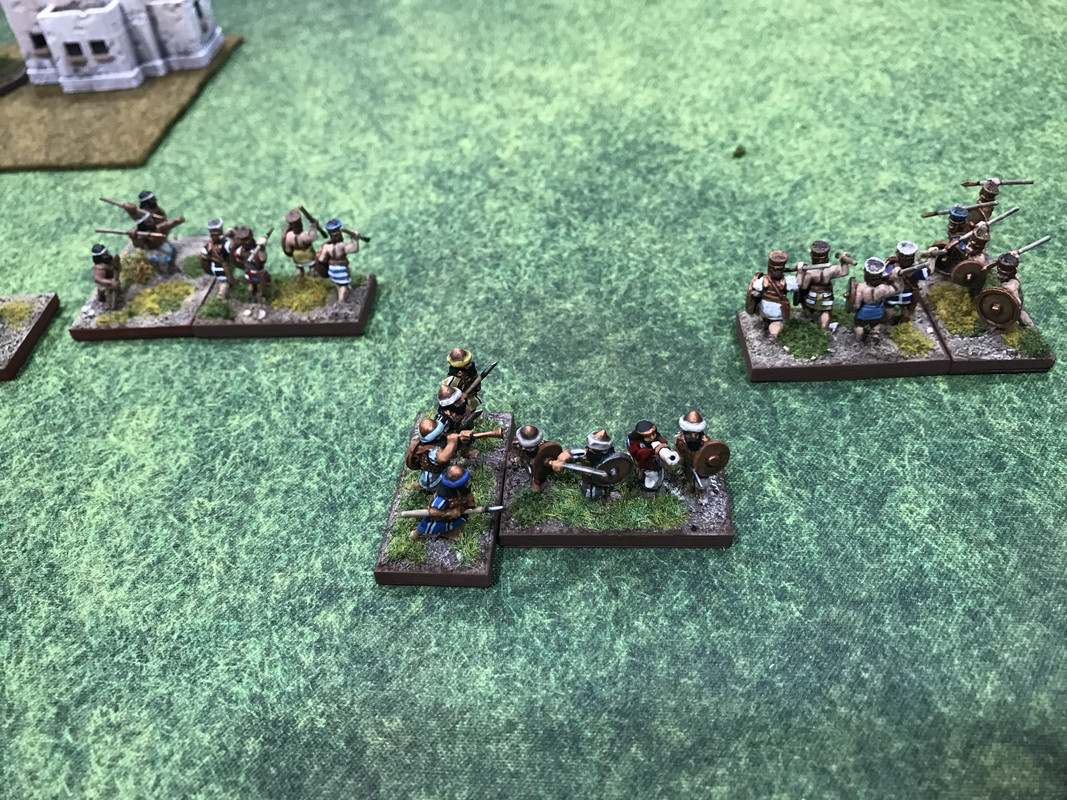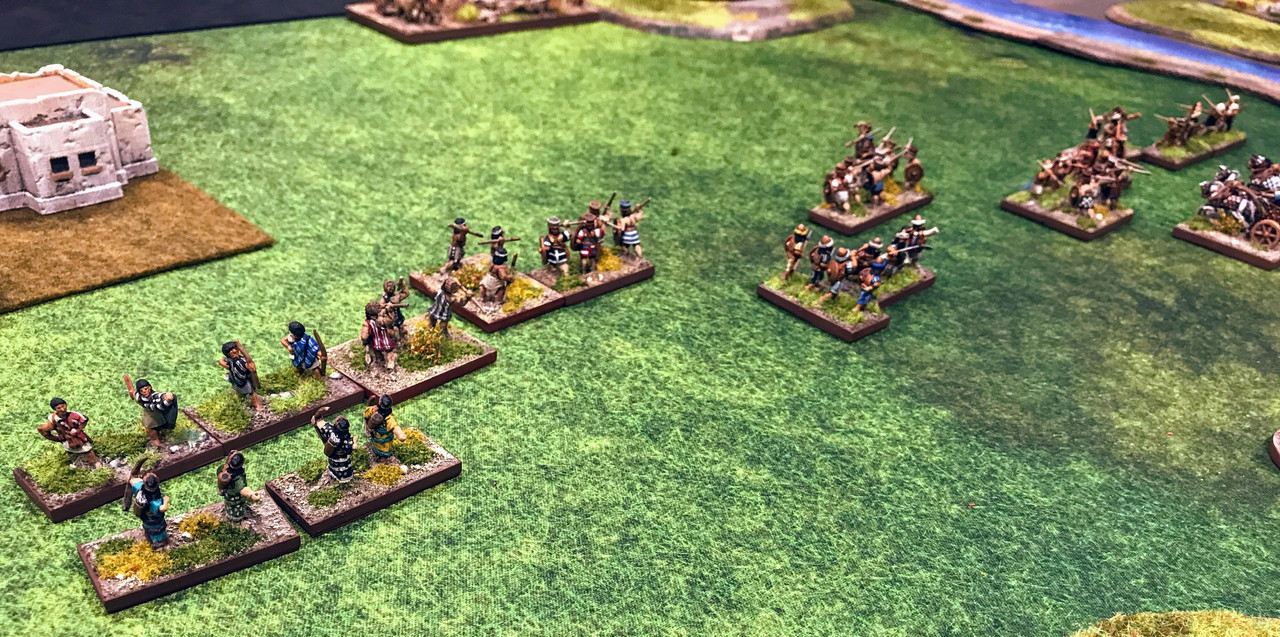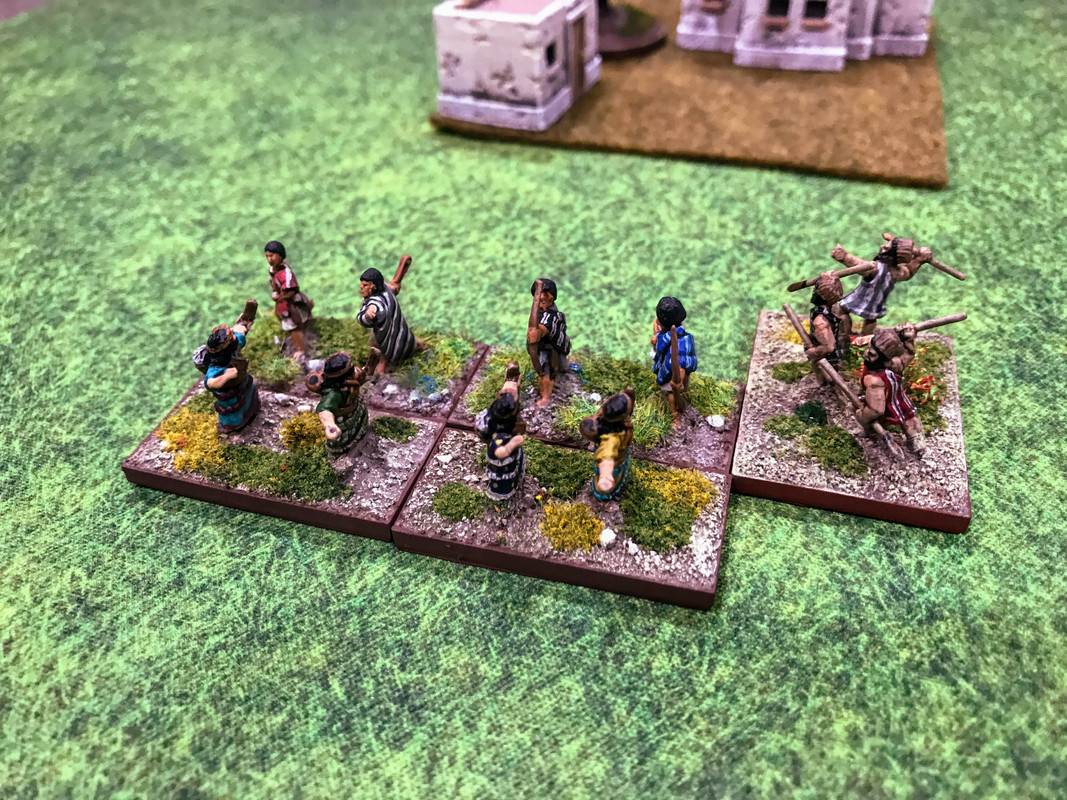Hebrews vs. Philistines
Posted: Mon Jun 06, 2022 12:03 am
My son-in-law, nephew and I played two battles of Triumph! on Friday using my 15mm Early Hebrew and Early Philistine armies. We used the standard two player game rules. My son-in law joined me on the Philistine side for the second battle; he took command of the infantry and I took the mounted elements. The second battle will be a separate post under this topic.
The Forces.
The Philistine Army had three Battle Taxis, six Raiders, two Skirmishers, two Rabble, and two Bow Levy. They also had the “Pack Trains and Herds” Battle Card allowing the camp to be placed anywhere on the base edge. My nephew commanded the Philistines.
The Hebrew forces were two Raiders, six Light Foot, four Warbands, one Bow Levy, and two Skirmishers. They also had the “Pack Trains and Herds” Battle Card allowing the camp to be placed anywhere on the base edge. In addition, the Hebrews had the Ambush Battle Card allowing light troops to be deployed in rough terrain beyond the normal deployment area. I commanded the Hebrews.
Before the Battle.
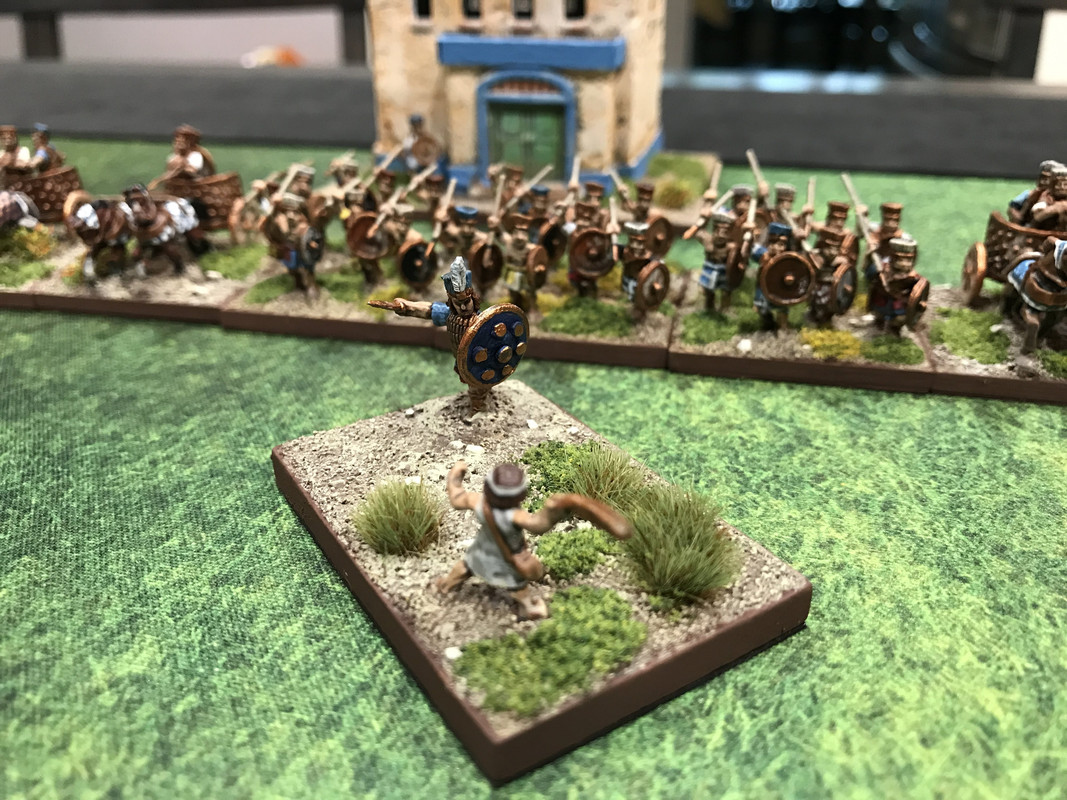
A young man with a sling confronts a Philistine hero as the army looks on.
The Battlefield.
There were five pieces of terrain. A village was located on the Philistine base line. Two steep hills were located on the Hebrew left flank. None of these played a part in the battle. There were two steep hills located in the center of the board that were significant because this allowed the Hebrew forces to set up in ambush.
Deployment.
The Hebrews put the two Skirmishers and the Bow Levy in ambush positions on two different hills. The Light Foot, Warbands, and Raiders were set up in a long line in the center and behind the hill on their right flank. One Warband was set to guard the camp.
The Philistines set up two Skirmishers and a Rabble to oppose the Hebrew Skirmishers. The Raiders and Bow Levy formed a phalanx in the center. The Battle Taxis set up on the Philistine left. One Rabble was detailed to guard the camp.
Initial Plans.
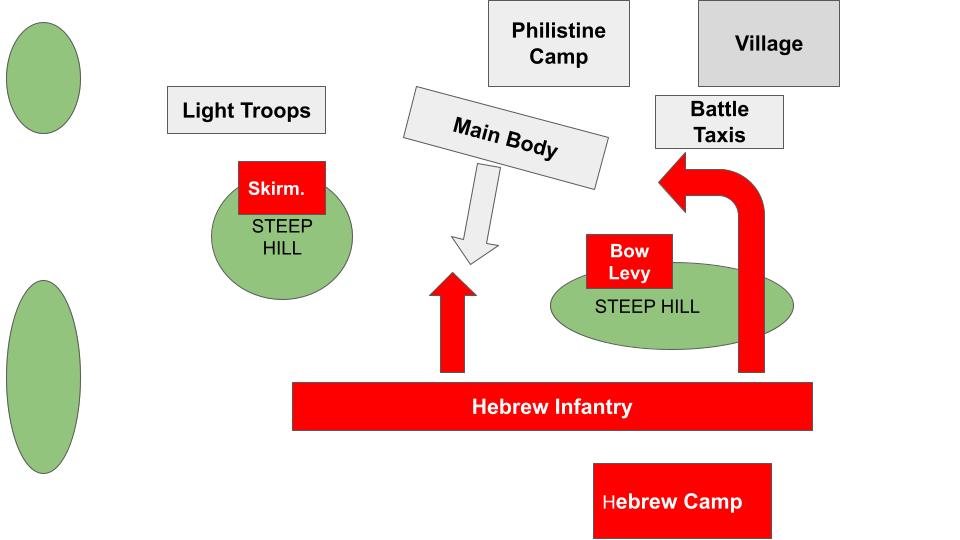
The Philistine plan was to use their own light troops to defeat the Hebrew skirmishers in ambush on the Hebrew left flank. The main body and the General would advance down the valley between the two steep hills in order to engage the more lightly-armed Hebrew infantry. The Battle Taxis on the Philistine right were a holding force.
The Hebrew plan was to limit Philistine movement with the ambushing forces while the numerically superior Hebrew infantry advanced over the steep hill to their front in order to envelop the Philistine left flank.
The Battle.
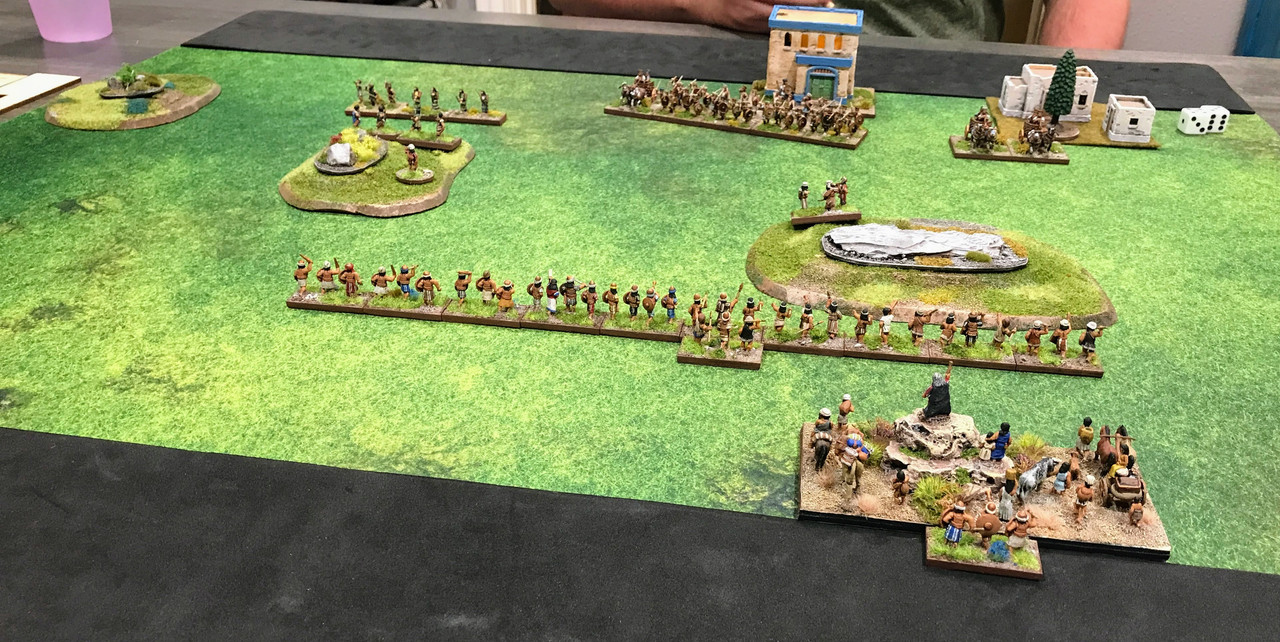
Overview of the battlefield from the Hebrew side.
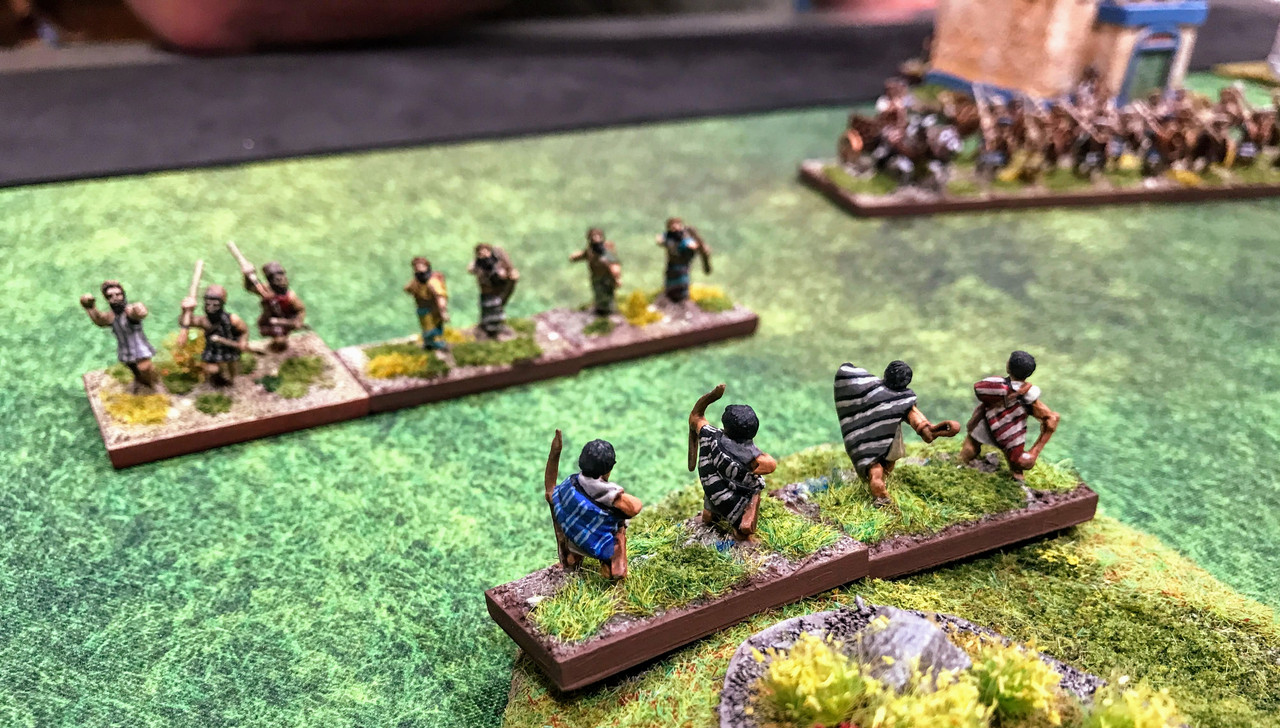
Slingers and bowmen of the Benjaminite tribe wait for the attack they know is sure to come.

Hebrew bowmen wait in the hills. They never looose a single arrow in the battle, but their presence helps limit the Philistine movement.
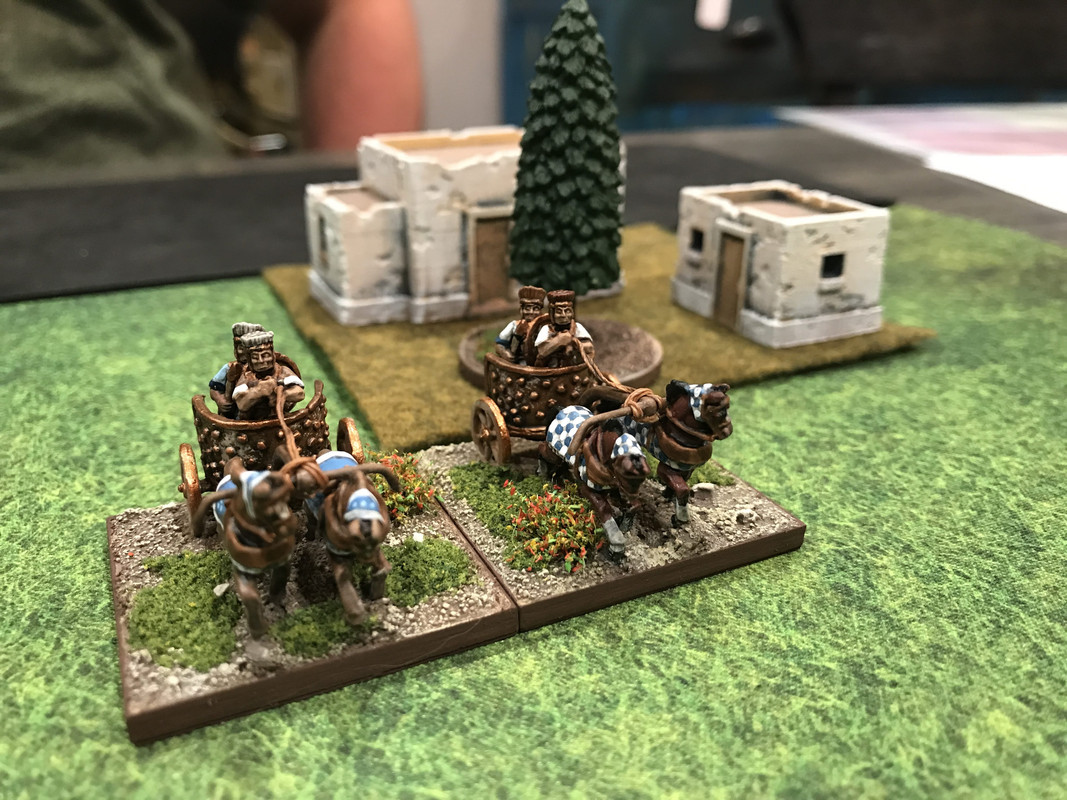
Nobles in their chariots, watching the hill to their front.
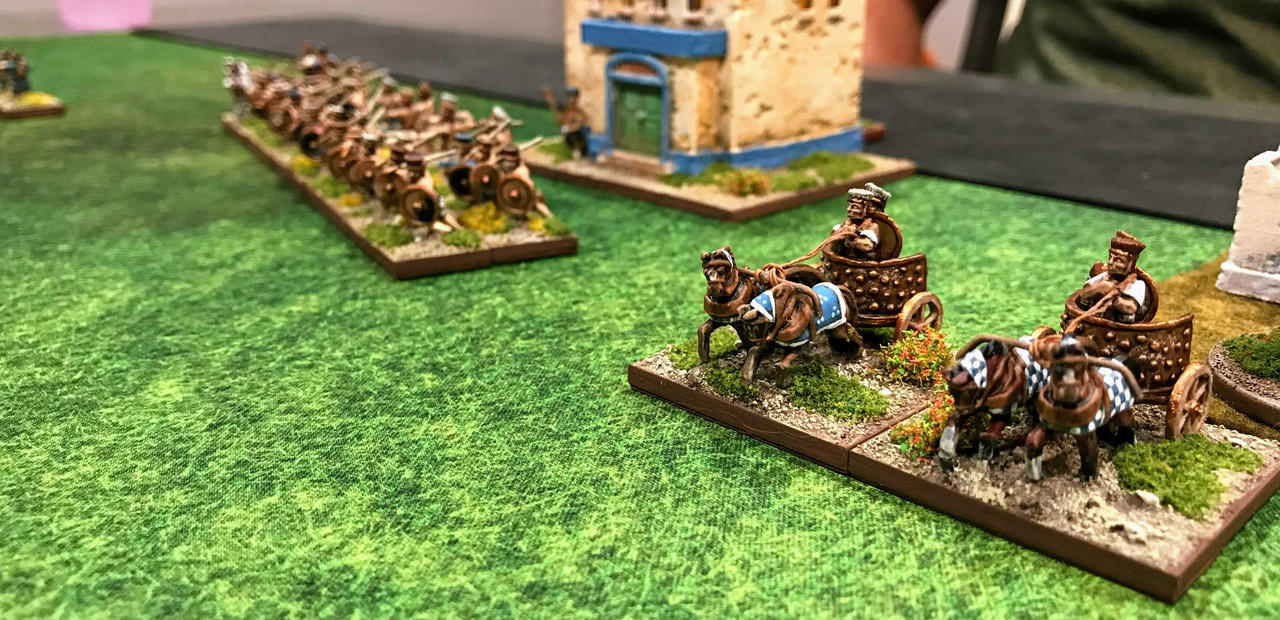
The main body gathers in front of the temple of Dagon.
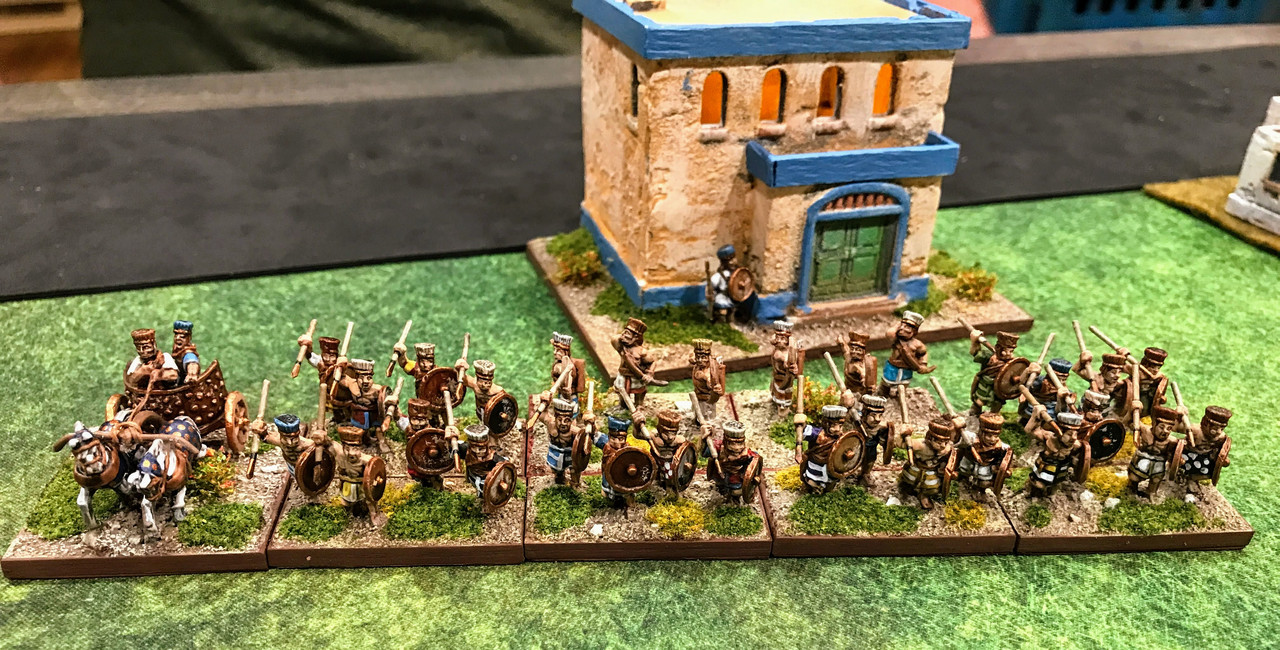
The Philistine general and the main body of troops. The fires of Dagon can be seen glowing in the windows. (It really does have flickering light; I have an LED candle inside).
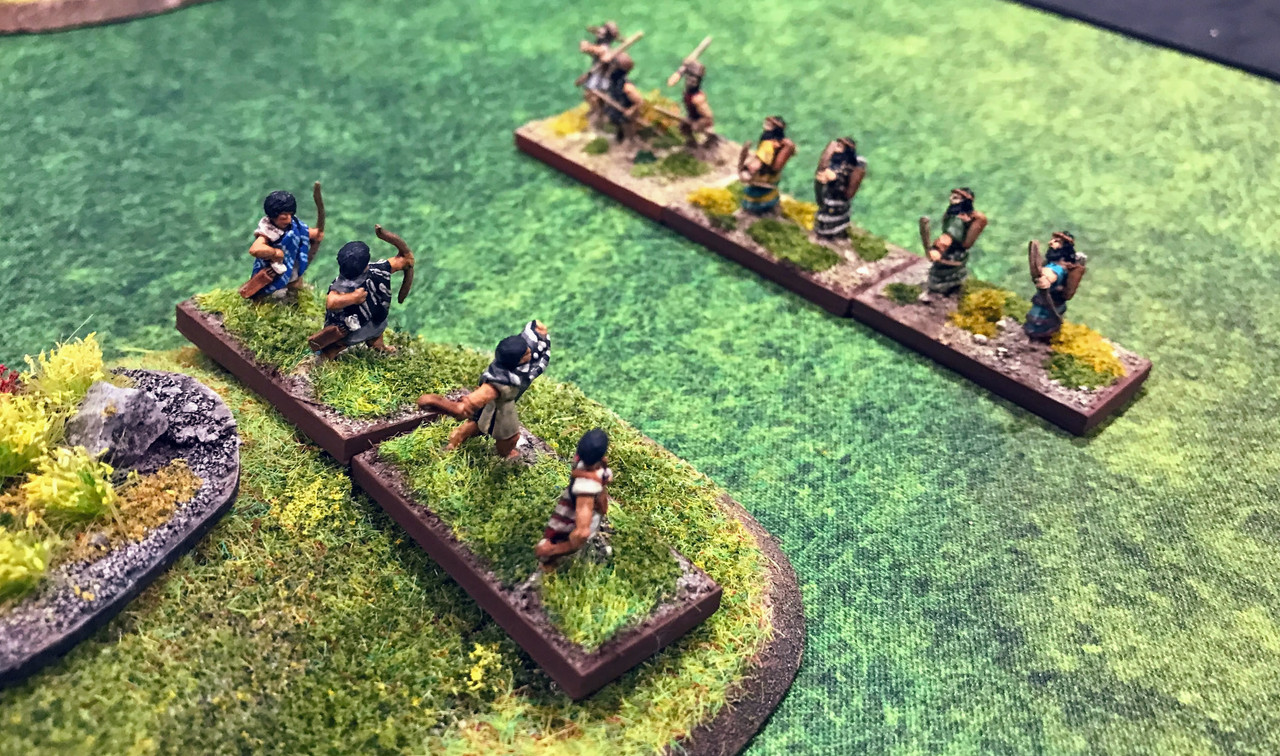
Men of the Kharu and Shasu tribe, although not Philistines, are brave and willing to go into the hills and fight the swarms of Hebrews they know are there.

View of the battlefield from the village.
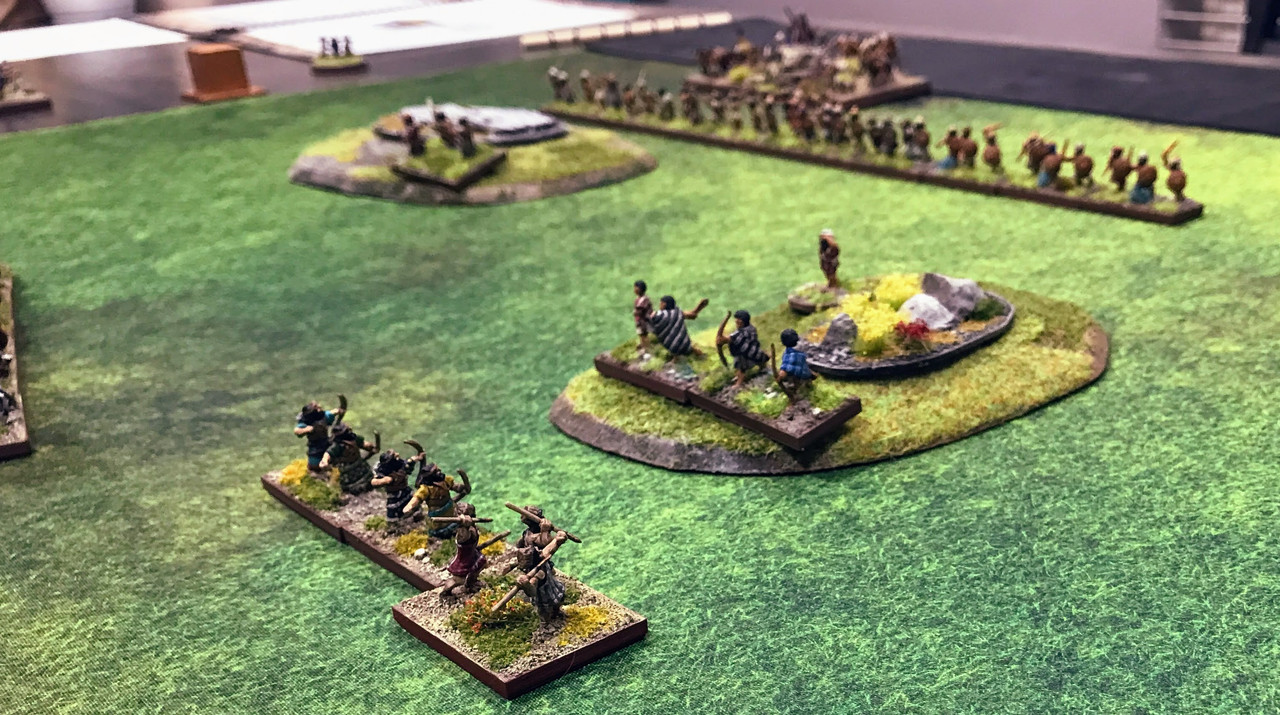
View from behind the Philistine right flank.

The battle begins in the hills.
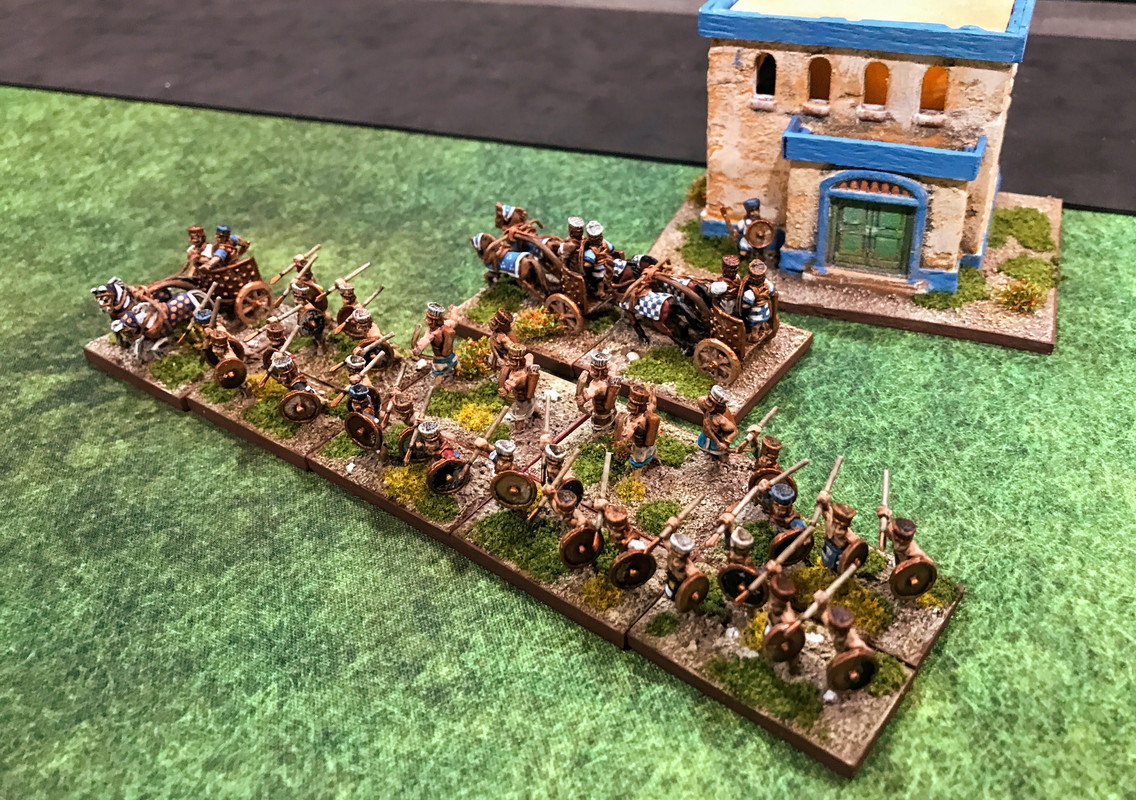
The Philistine general, seeing Hebrews coming over the steep hill in force, moves his chariots towards the opposite flank.

Hebrew tribesmen cross the hill and prepare to make contact.
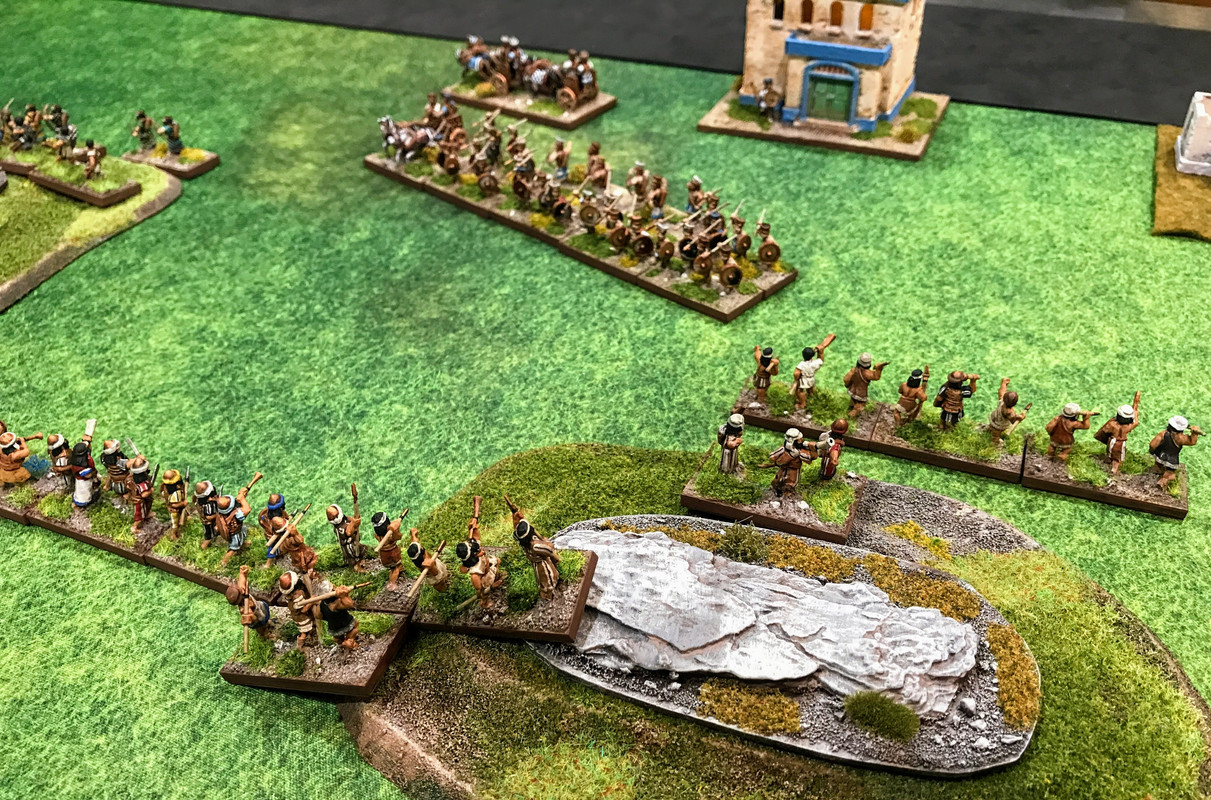
Another view of the enveloping attack.
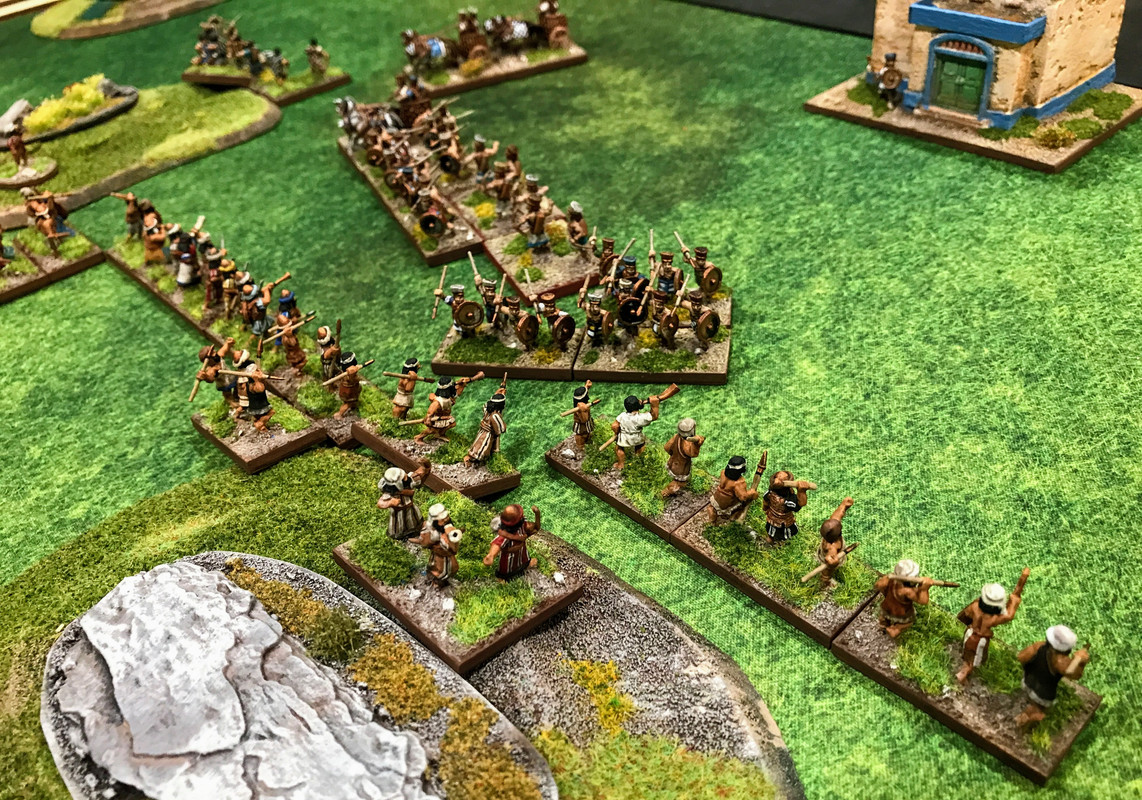
The Philistines turn to face the growing threat on their left.

Half of the Kharu fall under a hail of slingstones. The slingers boldly press the attack into the open ground.
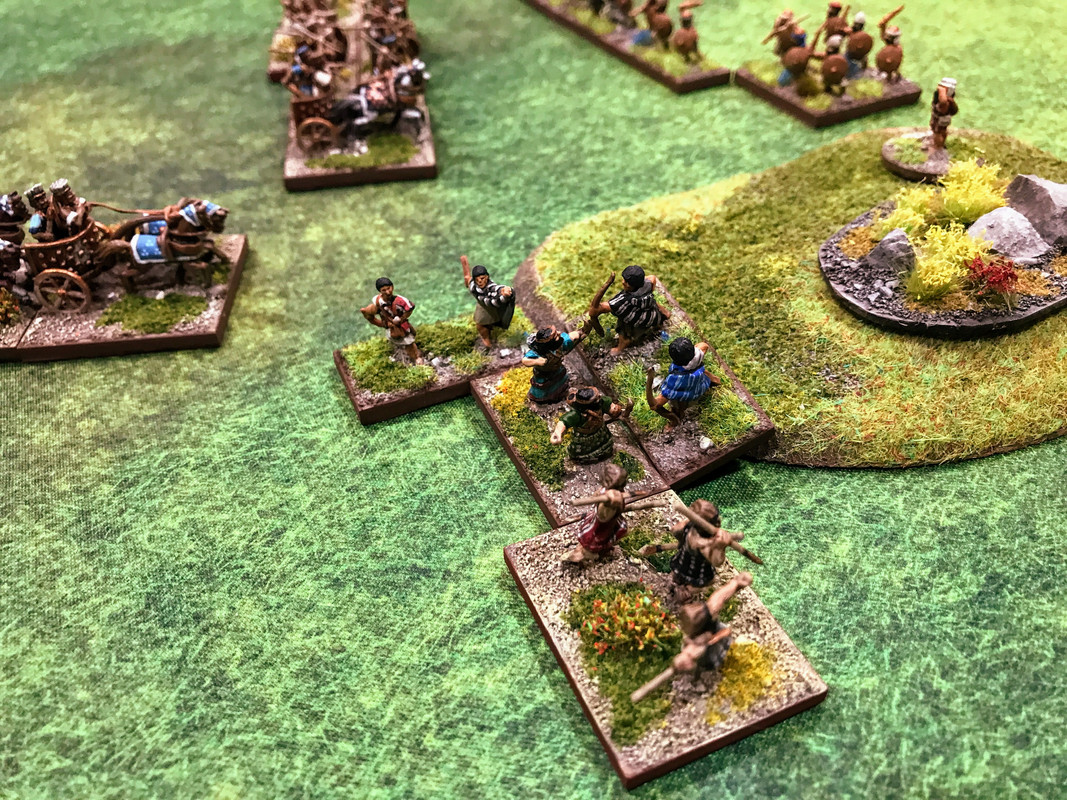
The youthful recklessness of the slingers puts them at risk from the enemy chariots.
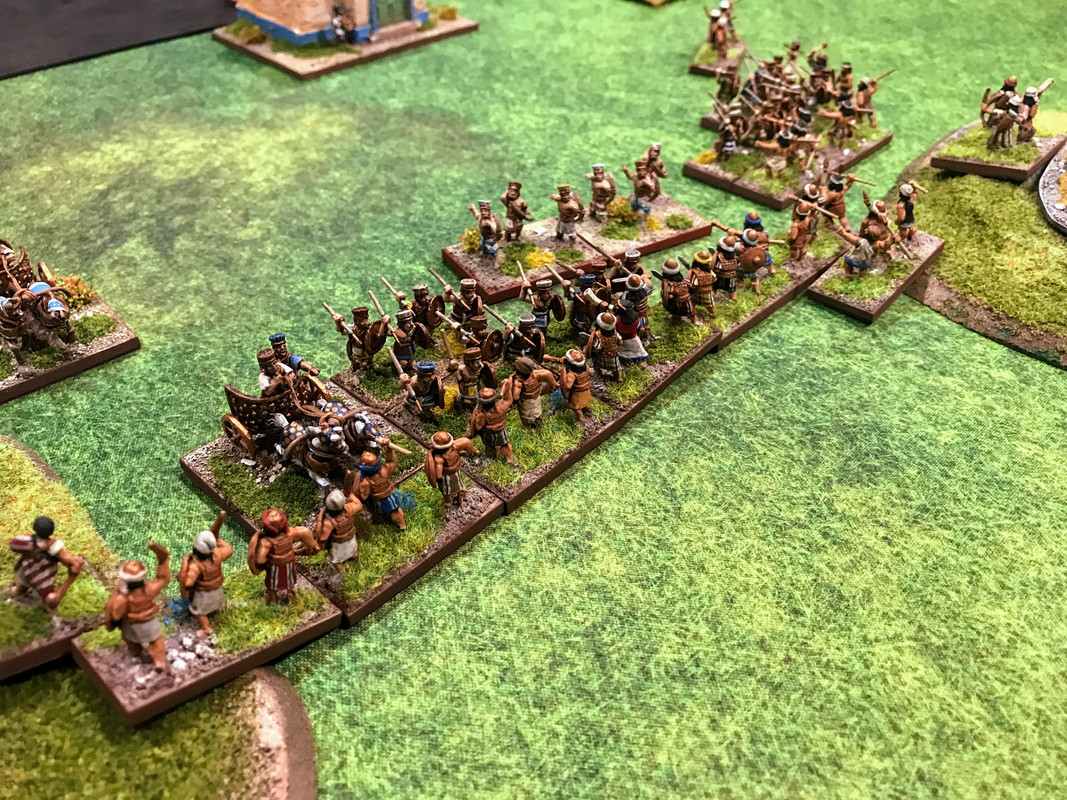
The main lines clash.
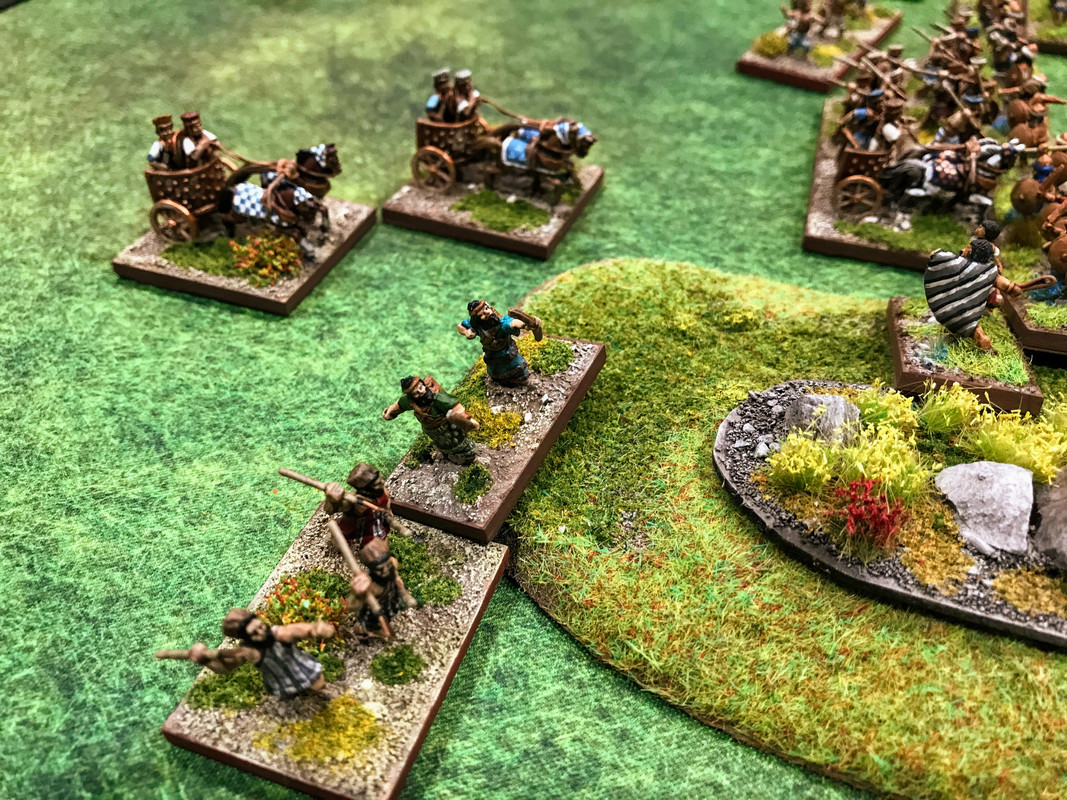
The Kharu and Shasu defeat the Benjaminite bowmen to their front. The slingers, attacked in the flank by Philistine chariots (Battle taxis), flee into the hills.
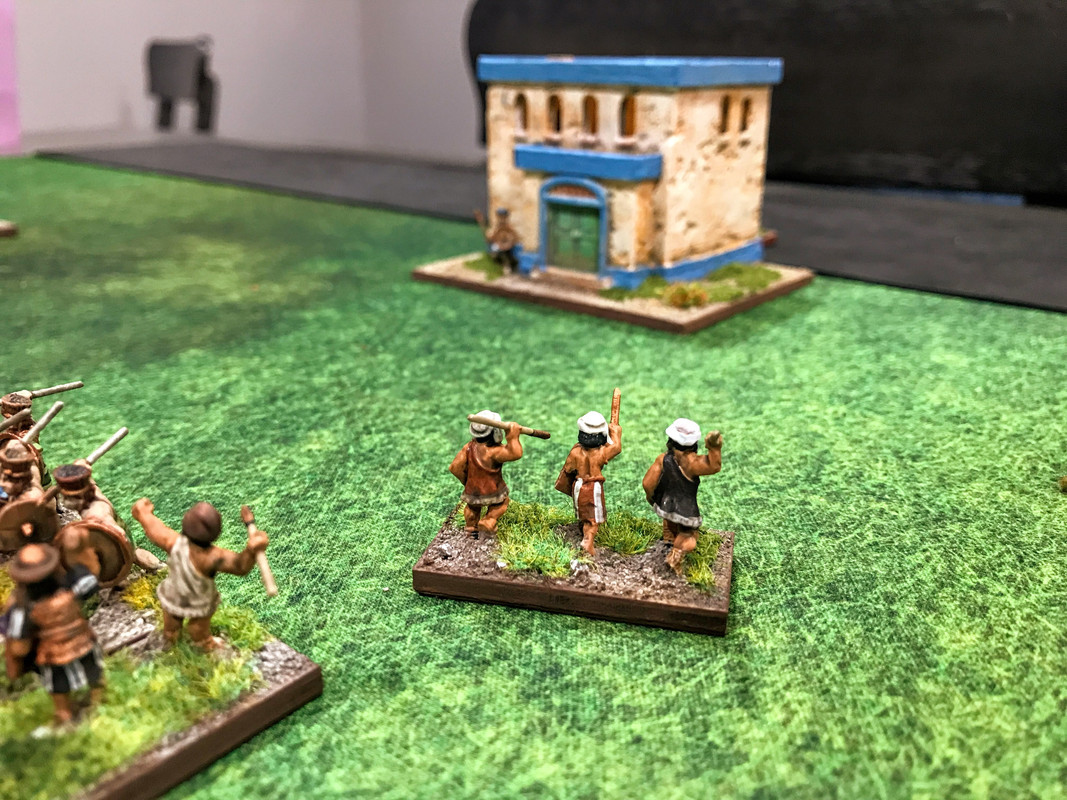
The foul Temple of Dagon must be destroyed.
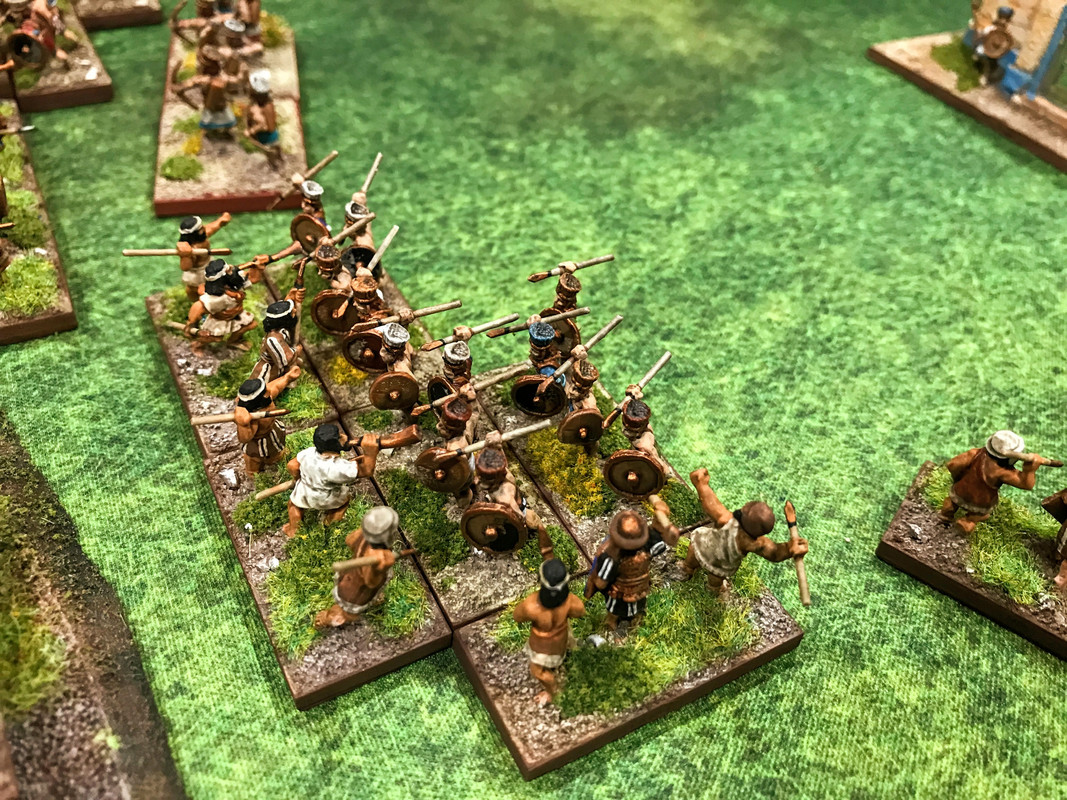
The Hebrew enveloping attack begins to wear down the enemy main body.
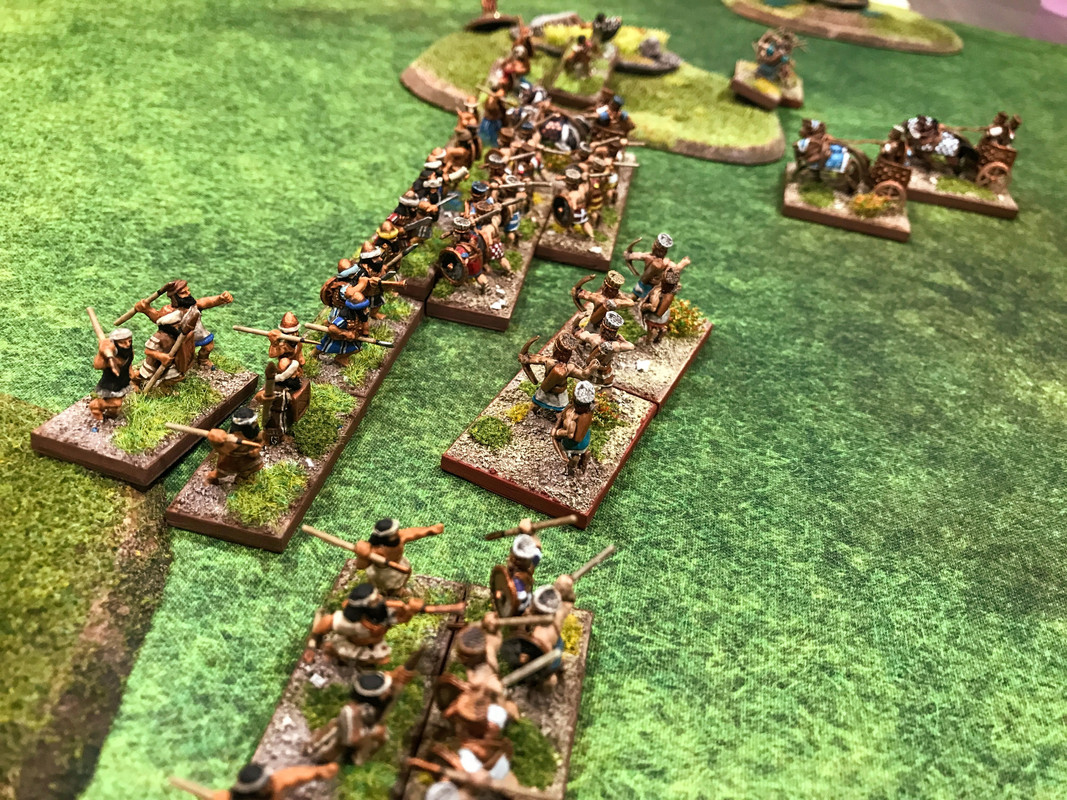
Fierce fighting in the center.
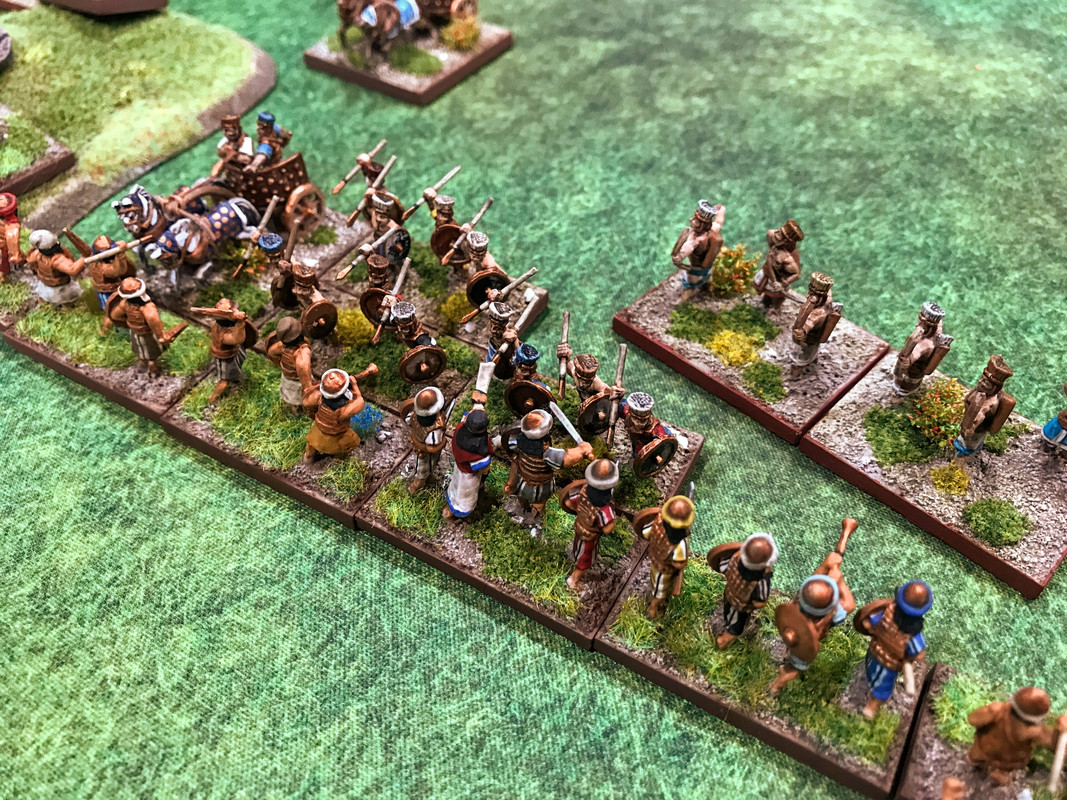
Warriors of the tribe of Simeon press in on the Philistine general.
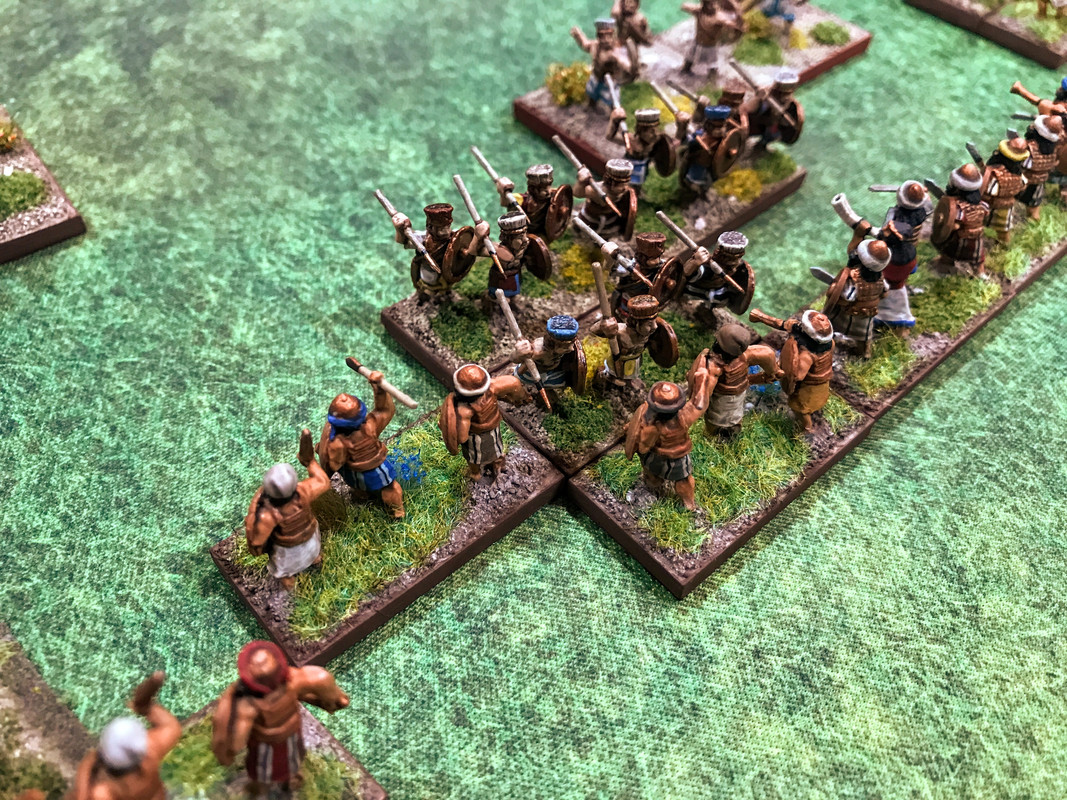
The battle turns decisively in the Hebrew's favor as the warriors of Simeon smite the Philistine general.
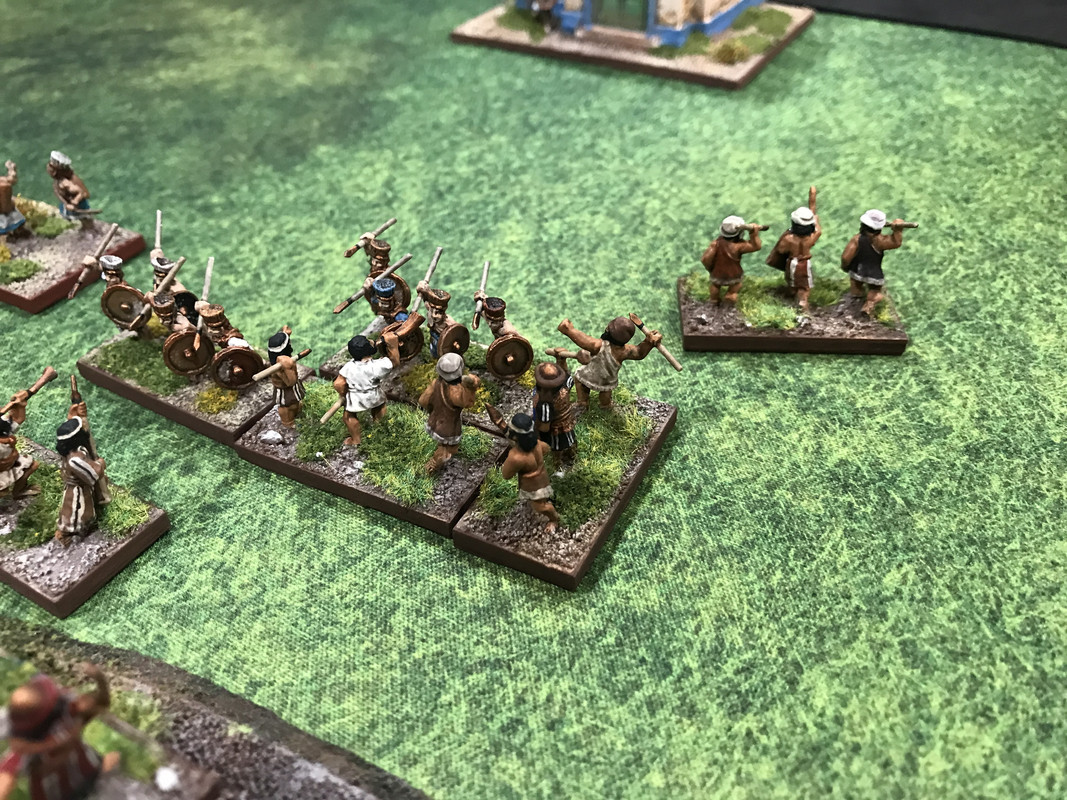
The Philistines on the left flank continue to fight despite the loss of their general.
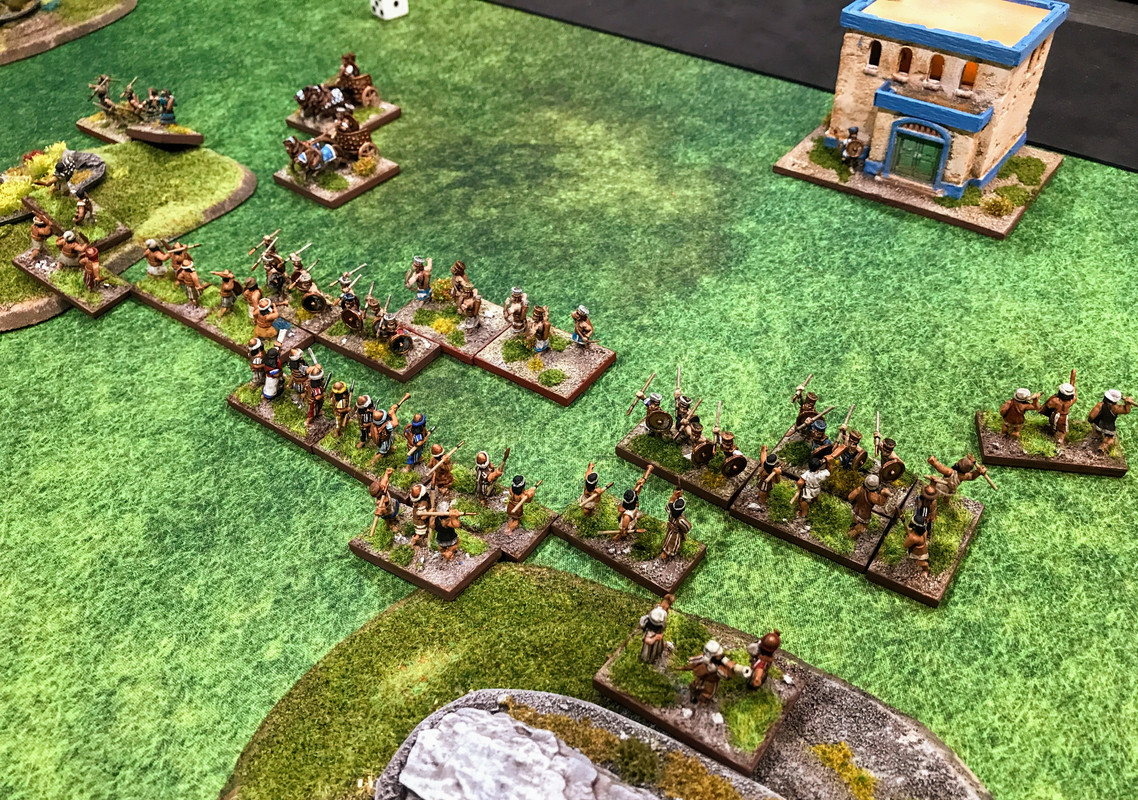
The Philistine center begins to give way.
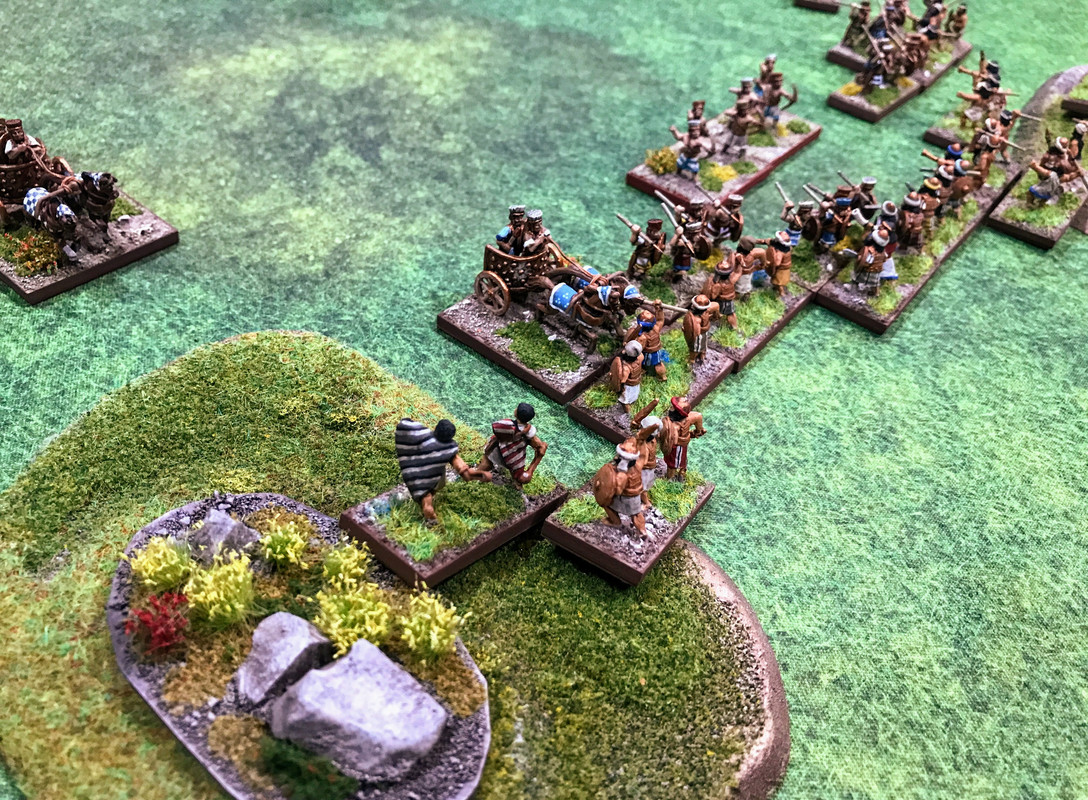
The battle ends with a Hebrew victory.
Conclusion.
We had another great time with this game. It took us about an hour from start to finish, including some time to look up rules questions. My nephew is a great player. The terrain, along with the Ambush battle card, heavily favored the Hebrews.
The Forces.
The Philistine Army had three Battle Taxis, six Raiders, two Skirmishers, two Rabble, and two Bow Levy. They also had the “Pack Trains and Herds” Battle Card allowing the camp to be placed anywhere on the base edge. My nephew commanded the Philistines.
The Hebrew forces were two Raiders, six Light Foot, four Warbands, one Bow Levy, and two Skirmishers. They also had the “Pack Trains and Herds” Battle Card allowing the camp to be placed anywhere on the base edge. In addition, the Hebrews had the Ambush Battle Card allowing light troops to be deployed in rough terrain beyond the normal deployment area. I commanded the Hebrews.
Before the Battle.

A young man with a sling confronts a Philistine hero as the army looks on.
The Battlefield.
There were five pieces of terrain. A village was located on the Philistine base line. Two steep hills were located on the Hebrew left flank. None of these played a part in the battle. There were two steep hills located in the center of the board that were significant because this allowed the Hebrew forces to set up in ambush.
Deployment.
The Hebrews put the two Skirmishers and the Bow Levy in ambush positions on two different hills. The Light Foot, Warbands, and Raiders were set up in a long line in the center and behind the hill on their right flank. One Warband was set to guard the camp.
The Philistines set up two Skirmishers and a Rabble to oppose the Hebrew Skirmishers. The Raiders and Bow Levy formed a phalanx in the center. The Battle Taxis set up on the Philistine left. One Rabble was detailed to guard the camp.
Initial Plans.

The Philistine plan was to use their own light troops to defeat the Hebrew skirmishers in ambush on the Hebrew left flank. The main body and the General would advance down the valley between the two steep hills in order to engage the more lightly-armed Hebrew infantry. The Battle Taxis on the Philistine right were a holding force.
The Hebrew plan was to limit Philistine movement with the ambushing forces while the numerically superior Hebrew infantry advanced over the steep hill to their front in order to envelop the Philistine left flank.
The Battle.

Overview of the battlefield from the Hebrew side.

Slingers and bowmen of the Benjaminite tribe wait for the attack they know is sure to come.

Hebrew bowmen wait in the hills. They never looose a single arrow in the battle, but their presence helps limit the Philistine movement.

Nobles in their chariots, watching the hill to their front.

The main body gathers in front of the temple of Dagon.

The Philistine general and the main body of troops. The fires of Dagon can be seen glowing in the windows. (It really does have flickering light; I have an LED candle inside).

Men of the Kharu and Shasu tribe, although not Philistines, are brave and willing to go into the hills and fight the swarms of Hebrews they know are there.

View of the battlefield from the village.

View from behind the Philistine right flank.

The battle begins in the hills.

The Philistine general, seeing Hebrews coming over the steep hill in force, moves his chariots towards the opposite flank.

Hebrew tribesmen cross the hill and prepare to make contact.

Another view of the enveloping attack.

The Philistines turn to face the growing threat on their left.

Half of the Kharu fall under a hail of slingstones. The slingers boldly press the attack into the open ground.

The youthful recklessness of the slingers puts them at risk from the enemy chariots.

The main lines clash.

The Kharu and Shasu defeat the Benjaminite bowmen to their front. The slingers, attacked in the flank by Philistine chariots (Battle taxis), flee into the hills.

The foul Temple of Dagon must be destroyed.

The Hebrew enveloping attack begins to wear down the enemy main body.

Fierce fighting in the center.

Warriors of the tribe of Simeon press in on the Philistine general.

The battle turns decisively in the Hebrew's favor as the warriors of Simeon smite the Philistine general.

The Philistines on the left flank continue to fight despite the loss of their general.

The Philistine center begins to give way.

The battle ends with a Hebrew victory.
Conclusion.
We had another great time with this game. It took us about an hour from start to finish, including some time to look up rules questions. My nephew is a great player. The terrain, along with the Ambush battle card, heavily favored the Hebrews.
